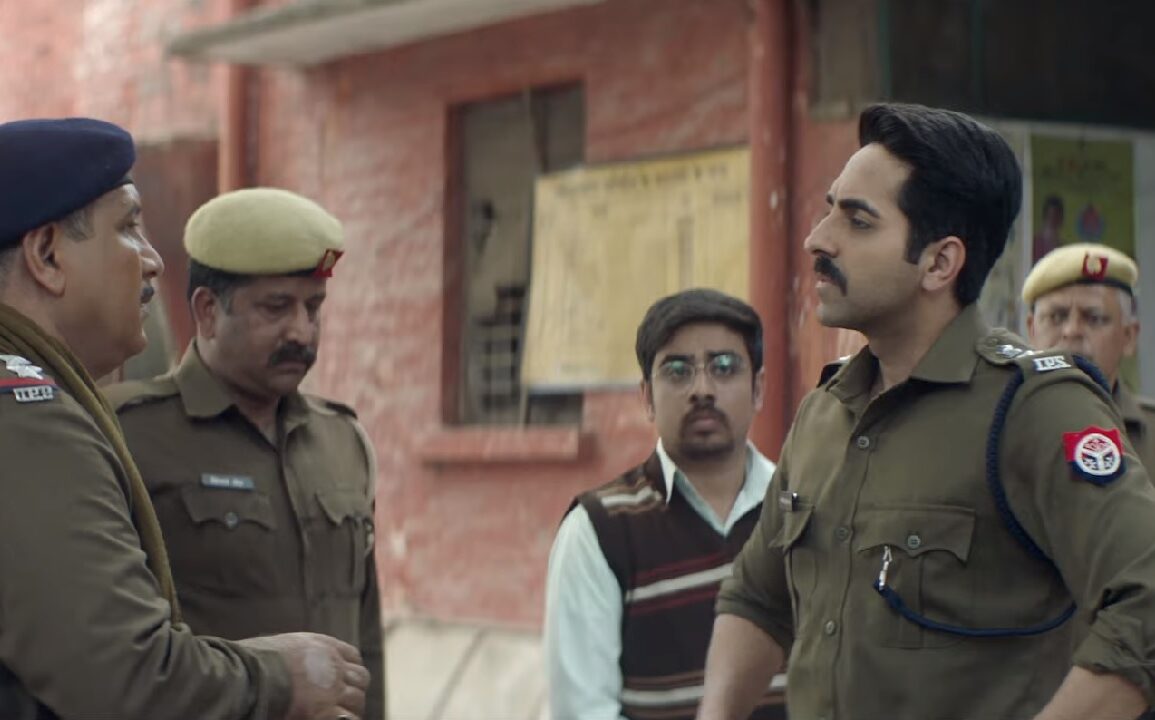The film commences with the folk song “Kahab To Lag Jai Dhakk Se” clearly serving the gist of the film and the setting. The statue of Dr B. R. Ambedkar in the backdrop confirms them as the people belonging to the lower class. The film doesn’t take much time; it comes to the cardinal point within a few minutes after rolling. Instantaneously, we hear Bob Dylan’s song when Ayaan a.k.a Ayushmann is travelling from Delhi to UP, giving his character a modern approach.
Two contrasting songs, one exemplifying the lower class and the other symbolising the upper class. After this song, we see Ayaan sitting on the backseat, and the steering is in the hands of the driver. Also metaphorically speaking about his character, which is also sitting in the backseat, unaware of the facts and the casteism that has been practising in the country
 If you’re contemplating a furious confrontation, where the protagonist will win in a brawl with the villain, then you’re mistaken. Because here it’s every individual vs themselves. Ayaan Ranjan (Ayushmann Khurrana) discovering the caste system so deeply entrenched in our country and in the process discovers himself perhaps not as a hero but, maybe someone who doesn’t wait for one.
If you’re contemplating a furious confrontation, where the protagonist will win in a brawl with the villain, then you’re mistaken. Because here it’s every individual vs themselves. Ayaan Ranjan (Ayushmann Khurrana) discovering the caste system so deeply entrenched in our country and in the process discovers himself perhaps not as a hero but, maybe someone who doesn’t wait for one.
Also, midway through the film, there’s this scene where he is in the driving seat, symbolising that now he’s the one who’s going to be driving this case and this village to justice. Here the villain and the hero is not there for the sake of making them scrimmage each other. Because the villain is not a guy, it is the system; it is the population.
 It’s not a fight again the evil forces; rather it is a fight to agnise one, to bring light about the plague that’s spreading through the society. The writers don’t coerce us with information saying this is a threat, or that is a threat. They just made the protagonist educate things, and that made us learn through him. Anubhav Sinha doesn’t beat around the bushes to point out the culprits. He does it in the initial frames itself. Rather, they are just used as pawns to get to the wider, voluminous truth. This is where the narrative gets strong. As you start to prognosticate things, you learn that they were meant to be predicted, so that you get distracted from the vast, wider plot and to get goosebumped on (is this even a word? But, just like our castes, does it matter?) your way to the end.
It’s not a fight again the evil forces; rather it is a fight to agnise one, to bring light about the plague that’s spreading through the society. The writers don’t coerce us with information saying this is a threat, or that is a threat. They just made the protagonist educate things, and that made us learn through him. Anubhav Sinha doesn’t beat around the bushes to point out the culprits. He does it in the initial frames itself. Rather, they are just used as pawns to get to the wider, voluminous truth. This is where the narrative gets strong. As you start to prognosticate things, you learn that they were meant to be predicted, so that you get distracted from the vast, wider plot and to get goosebumped on (is this even a word? But, just like our castes, does it matter?) your way to the end.
The film successfully carries out the task to make us think about the mentality of oneself and the people. It glorifies those people as heroes, whom we don’t even consider as humans in the first place. It educates us about the fact that sometimes, heroes are not the ones with a uniform or with powers. Perhaps they come every day, in the form of cleaners, sanitation workers, labours.

